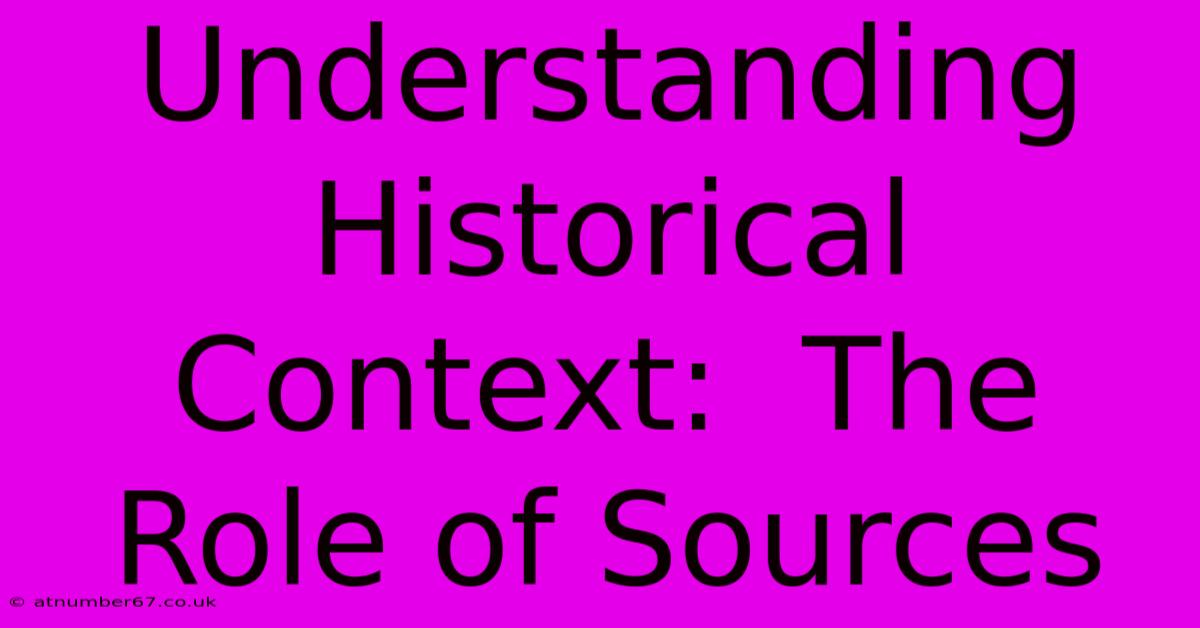Understanding Historical Context: The Role Of Sources

Table of Contents
Understanding Historical Context: The Role of Sources
History isn't just a collection of dates and names; it's a complex tapestry woven from countless individual experiences, events, and interpretations. To truly understand the past, we need to delve into its context, and the key to unlocking that context lies in the sources we use. This article explores the crucial role of historical sources in understanding the past, examining their different types, biases, and how to critically evaluate them.
Types of Historical Sources
Historical sources are broadly categorized into two types: primary and secondary.
Primary Sources: A First-Hand Account
Primary sources offer direct evidence about a historical event, object, person, or work of art. These are materials produced during the time period being studied, offering a firsthand perspective. Examples include:
- Original Documents: Letters, diaries, speeches, manuscripts, official records (e.g., government documents, court records), and legal documents.
- Creative Works: Literature, music, art, and architecture created during the period.
- Relics: Artifacts such as tools, clothing, furniture, and other physical objects.
- Oral Histories: Recorded interviews with people who experienced the events being studied.
Understanding the context of a primary source is vital. A letter written during a war, for example, may reflect the writer's personal experiences and emotions, which might differ significantly from the official accounts. Analyzing the creator, their intended audience, and the purpose behind the creation are crucial steps.
Secondary Sources: Analysis and Interpretation
Secondary sources analyze, interpret, or summarize primary sources. They provide a more distanced perspective, offering interpretations and analyses of historical events. Examples include:
- Scholarly Articles: Peer-reviewed articles published in academic journals.
- Books: Histories and biographies.
- Textbooks: Educational materials summarizing historical information.
- Documentaries: Films presenting historical narratives.
While secondary sources are valuable for gaining a broader understanding, it's crucial to remember they are interpretations of the past, shaped by the author's perspective and the historical context in which they were written. It's essential to be aware of potential biases and to consult multiple secondary sources to get a more well-rounded understanding.
Bias and Perspective: The Challenges of Interpretation
No historical source is entirely objective. All sources are influenced by the biases, beliefs, and perspectives of their creators. Understanding these biases is paramount to accurate historical interpretation. For example, a government report might present a biased view of a social movement, while a personal diary might offer a more intimate but potentially limited perspective.
Identifying Bias: Consider the following when evaluating a source's bias:
- The author's background: Their social class, gender, ethnicity, and political affiliations.
- The purpose of the source: Why was it created? What message was the creator trying to convey?
- The audience: Who was the source intended for? How might this influence its content?
- The historical context: What broader social, political, and economic forces shaped the source?
Utilizing Multiple Sources: Building a Comprehensive Understanding
A crucial step in understanding historical context is to use multiple sources from diverse perspectives. Comparing and contrasting different accounts can reveal inconsistencies, biases, and gaps in the historical record, leading to a more nuanced and complete understanding. Triangulation – using three or more sources to corroborate information – is a powerful technique for ensuring accuracy and reliability.
Conclusion: The Importance of Critical Analysis
Understanding historical context is essential for creating a meaningful and accurate portrayal of the past. The sources we use are the building blocks of our historical understanding, but it's vital to critically evaluate these sources, acknowledging their biases and limitations. By employing a multi-faceted approach, utilizing diverse sources, and understanding the influence of context, we can move closer to a richer, more comprehensive understanding of history. The past is not a fixed entity; it is a constantly evolving narrative, shaped by our interpretation of the sources that have survived to the present day.

Thank you for visiting our website wich cover about Understanding Historical Context: The Role Of Sources. We hope the information provided has been useful to you. Feel free to contact us if you have any questions or need further assistance. See you next time and dont miss to bookmark.
Featured Posts
-
The Surprising Truth About Carmen Montero Mundts Age
Apr 05, 2025
-
Breaking Bad Rewind Did Walter White Kill His Son
Apr 05, 2025
-
Discover Sanjay Bangars Sons Inspiring Story
Apr 05, 2025
-
How Much Is Twiggy Worth The Shocking Truth
Apr 05, 2025
-
Gilded Age A Nation Divided
Apr 05, 2025
